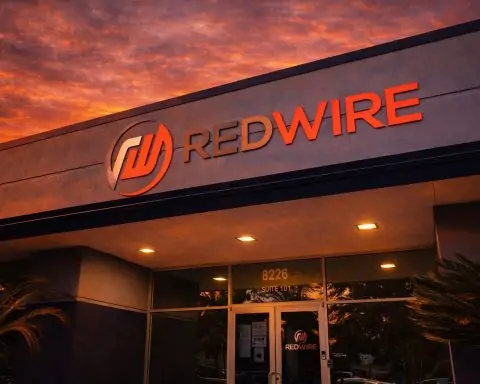- In 2024, Rocket Lab surged over 360%, Intuitive Machines jumped 720%, and Redwire climbed 436% amid a wave of small-cap space-stock rallies.
- By early 2025, many space stocks retraced 40–60% from their 2024 highs as investors reassessed profitability and valuations.
- Rocket Lab USA (NASDAQ: RKLB) reported Q1 2025 revenue of $122.6 million, up 32% year over year, with a backlog of $1.07 billion, five Electron launches in the quarter, and Neutron selected for a $5.6 billion U.S. Space Force launch program, while 2025 revenue guidance remains about 30% higher.
- Virgin Galactic (NYSE: SPCE) saw its stock fall about 50% in 2024 and continue to lag in 2025 as it works toward ramping flights and long-run profitability.
- Iridium Communications (NASDAQ: IRDM) posted Q1 2025 revenue of $214.9 million and net income of $30.4 million, with guidance for 2025 service-revenue growth of 5–7%, roughly $495 million in EBITDA, a dividend increase of about 5%, and a $469 million stock buyback.
- Europe’s satellite landscape was reshaped by Eutelsat’s 2023 merger with OneWeb to create a multi-orbit broadband provider, and by May 2025 Eutelsat reported €300 million in quarterly revenue with OneWeb operating 618 satellites.
- SES S.A. delivered about €2.0 billion in revenue in 2024, its O3b mPOWER constellation is coming online, the stock has underperformed due to video-business concerns, and the company signaled a possible sale of its minority stake in O3b networks.
- Avio S.p.A., the Italian Vega launcher maker, posted roughly €300 million in 2024 revenue with profitability hit by launch delays, as Vega-C upgrades proceed and Ariane 6 delays push Europe to bolster domestic launch firms with EU funding.
- China Satellite Communications Co. (601698) reported about 5% revenue growth in 2024 as it supports China’s DFH satellites and the planned Guowang national constellation, with the stock trading around CNY 19–20 and offering a modest dividend.
- Global private-space funding reached about $8.6 billion in 2024, up 25% year over year, with SpaceX valued at roughly $350 billion after a $1.25 billion secondary sale, underscoring private capital’s influence on the broader space market.
The space industry is experiencing a new wave of growth and investor excitement. From satellite communications providers to rocket launch startups, companies around the world have seen stock prices soar over the past year, followed by a period of consolidation. This report dives into the current stock market performance of publicly traded satellite and space-related companies globally, highlights major private space firms and their funding, and examines the market trends, technological developments, and geopolitical factors shaping the industry’s future. All regions – North America, Europe, Asia, and beyond – are contributing to the accelerating “new space” economy, which some analysts project to reach $1 trillion by 2040 [1]. Below, we break down the latest financial results, forecasts, and strategic outlooks across the global space sector.
Publicly Traded Space Companies Worldwide: Performance & Outlook
Publicly traded satellite and space companies have delivered mixed performance recently, with spectacular gains in 2024 giving way to volatility in early 2025. In 2024, a number of small-cap “pure play” space stocks saw explosive rallies: for example, Rocket Lab surged over 360% thanks to record launch rates, Intuitive Machines jumped 720% amid lunar mission contracts, and Redwire climbed 436% on high-profile space infrastructure projects [2]. This reflected strong investor enthusiasm for the expanding space economy, bolstered by projections of long-term growth (e.g. a ~$1 trillion space market by 2040) [3]. However, 2025 brought a stark reversal, as broader market risk-aversion hit speculative tech stocks. Many space stocks retreated from their highs – profit-taking and valuation concerns drove sharp declines of 40–60% in some names by early 2025 [4]. Investors began to reassess these often-unprofitable firms despite their revenue growth. Below we review key public space companies by region, their recent financial performance, and forward-looking forecasts.
North America: Launchers, Satellite Operators & Space Tech Firms
North America hosts the largest cohort of space-related stocks, ranging from pure-play rocket launchers and satellite operators to aerospace & defense giants with space divisions:
- Rocket Lab USA (NASDAQ: RKLB) – Small-launch specialist. After its 360% surge in 2024, Rocket Lab’s stock pulled back in 2025 but remains on a long-term uptrend [5] [6]. The company’s Q1 2025 earnings showed $122.6 million revenue, up 32% YoY [7], driven by a record five Electron launches in the quarter and growth in its space systems segment. While it missed EPS expectations slightly (Q1 net loss of $0.12 per share) [8], Rocket Lab is expanding aggressively – its backlog hit $1.07 billion and it’s developing the larger Neutron rocket, which was just selected for a $5.6 billion U.S. Space Force launch program [9]. Forward outlook: management expects robust growth to continue, with 2025 revenue guided to rise ~30% and plans for ~15 Electron launches this year. The company is also vertically integrating (e.g. acquiring satellite communications firm Mynaric) to capture more of the space supply chain [10]. Investors remain optimistic given Rocket Lab’s technical momentum (the stock has held key support and is viewed as “technically bullish” by analysts despite recent volatility [11]).
- Virgin Galactic (NYSE: SPCE) – Space tourism pioneer. Virgin Galactic’s stock has struggled after its 2021 hype; it traded near all-time lows through 2024–25 as the company burns cash and delays commercial service. The firm finally flew its first paying tourists to suborbital space in mid-2023, but revenues remain minimal and losses large. Forecast: Virgin Galactic aims to ramp up flights in 2025, yet profitability is distant. The stock’s performance reflects skepticism; shares fell ~50% in 2024 and have continued to lag in 2025, indicating that investors need to see sustained flight activity before confidence returns (no significant near-term earnings catalysts expected).
- Iridium Communications (NASDAQ: IRDM) – Satellite network operator (LEO communications). Iridium provides global satellite voice and data services and has been a steady performer. In Q1 2025, Iridium’s revenue rose 5% to $214.9 million [12], and net income jumped to $30.4 million (from $19.7 M a year prior) [13]. The company reaffirmed full-year 2025 guidance of 5–7% service revenue growth and ~$495 M operational EBITDA [14] [15]. Key drivers include growing demand for Iridium’s IoT connectivity (commercial IoT subscribers up 7% YoY) and a stable U.S. military contract for mobile satcom services [16] [17]. Iridium is also rolling out a new direct-to-device smartphone satellite messaging service in partnership with semiconductor firms, tapping into the trend of satellite-cellular integration [18]. Market impact: Unlike volatile space SPAC stocks, Iridium offers consistent cash flow – its shares were up ~15% over the past year as of Q2 2025 [19]. The company is using this stability to reward shareholders (recently hiked its dividend ~5% and is executing a $469 M stock buyback in 2025) [20]. Going forward, Iridium’s outlook is cautiously optimistic: continued modest growth in commercial services and government business, with a focus on higher-margin offerings (e.g. specialty timing/location services) to offset any softness in legacy voice markets [21].
- Satellite Broadband Operators (Viasat, EchoStar, etc.) – Viasat (NASDAQ: VSAT) completed its acquisition of Inmarsat in 2023, creating a major GEO satellite broadband player. However, a Viasat-3 satellite malfunction in mid-2023 hurt capacity expansion. Meanwhile, EchoStar (NASDAQ: SATS) in the U.S. and Telesat (TSX: TSAT) in Canada are pursuing their own next-gen constellations. Stock performance: These traditional operators have faced pressure from Starlink’s competition and high capital expenditures. Telesat’s stock, for instance, plunged when its LEO project funding was uncertain, but recovered in late 2023 after securing financing for its Lightspeed constellation. Investors remain cautious and will watch earnings for signs that these incumbents can profitably fill niches that Starlink/OneWeb don’t serve. Forecasts: expect flat to modest revenue growth for GEO operators, with upside if new constellations (Lightspeed, Viasat-3) come online successfully.
- Aerospace & Defense Primes (Lockheed Martin, Northrop Grumman, Boeing) – These large contractors are not pure space plays but are major space hardware producers (satellites, launch systems, etc.). Their stock performance has been solid, driven by defense spending increases. For example, Northrop Grumman (NYSE: NOC) reported growth in its Space Systems segment in 2024 (e.g. contracts for missile-warning satellites), contributing to a 7% revenue rise [22]. Lockheed Martin (NYSE: LMT) likewise has a record ~$150 B backlog including NASA’s Orion capsule and numerous military space programs. These stocks trade more on defense budget outlooks than on commercial space trends. Forecast: With geopolitical tensions high, U.S. defense contractors expect stable growth; Lockheed’s 2025 guidance, for instance, calls for low-single-digit sales growth and robust free cash flow, supported by satellite and missile-defense orders. In short, traditional aerospace stocks are benefiting from the space sector’s national security importance, even if they lack the explosive swings of pure-plays.
Europe: Satellite Operators & Emerging Space Pure-Plays
Europe’s publicly traded space companies include several satellite operators and technology firms:
- Eutelsat Group (EPA: ETL) – Satellite operator (GEO + LEO). France-based Eutelsat made headlines by merging with British LEO constellation OneWeb in late 2023, aiming to create a “multi-orbit” broadband provider. The transition has been challenging: since merger talks began, Eutelsat’s stock slid ~50% amid investor skepticism about OneWeb’s profitability [23]. In May 2025, Eutelsat reported quarterly revenue of €300 M, slightly down 1.9% YoY but in line with forecasts [24]. Notably, its Government services segment grew 10% as European and other non-U.S. governments seek secure satellite communications alternatives (demand for non-American systems has risen given geopolitics) [25]. OneWeb’s LEO network (over 600 satellites deployed) is attracting new government customers, though it still trails SpaceX’s Starlink (7,000+ satellites) in scale [26] [27]. Outlook: Eutelsat affirmed its full-year revenue outlook and is actively seeking new financing partners to fund future satellite deployments [28] [29]. The company expects modest near-term revenue pressure (it lost €16 M due to EU sanctions cutting off Russian TV broadcast business) but is banking on growth from OneWeb services as that constellation is fully commercialized. Investors will be watching how quickly OneWeb can ramp up sales (e.g. in maritime and military broadband) and whether the combined Eutelsat-OneWeb can fend off Starlink in key markets. So far, the stock reaction has been cautious, but any breakthrough government deals or a stabilizing of capital expenditures could improve sentiment.
- SES S.A. (Luxembourg: SES) – Satellite operator (GEO + MEO). SES operates both geostationary satellites and the O3b mPOWER medium-Earth-orbit constellation. The company delivered stable results in 2024, with revenue around €2 billion (flat YoY) as growth in network services offset declining video broadcast revenues [30]. SES hit the top end of its 2024 guidance and generated solid EBITDA, thanks in part to big contracts for inflight connectivity and U.S. government usage. Forecast 2025: SES is cautiously optimistic – its new O3b mPOWER satellites are coming online, which should drive networks segment growth (mobility and cloud connectivity demand is high). However, the stock has underperformed historically due to concerns about the video business and a failed merger attempt with Intelsat. Investors will look for SES to outline post-2024 growth once the costly mPOWER rollout is complete. Recent strategic news includes SES considering a sale of its minority stake in O3b networks and refocusing on core data services. The European government’s IRIS² initiative (an EU-backed multi-orbit constellation plan) could also provide future revenue opportunities to SES and its peers.
- Avio S.p.A. (BIT: AVIO) – Rocket manufacturer (Italy). Avio produces the Vega small launch vehicle for Arianespace. After some Vega launch failures in 2020–21, Avio’s stock struggled. The company has been working on upgrades (Vega-C) and received European Space Agency support. In 2024, Avio’s revenues were stable (~€300 M) but profitability was hit by launch delays. Outlook: Europe’s launch sector is in flux – with Ariane 6 delayed and reliance on SpaceX rising, the European Commission and ESA have boosted funding for domestic launch firms like Avio. Avio expects a rebound once Vega-C is fully operational (possibly 2025) and is also developing a next-gen Vega-E. The Italian government’s increased space budget and NATO’s space initiatives provide a tailwind. Still, competition from emerging private EU launch startups (see below) looms. Avio’s stock could see upside if it secures new launch contracts or if Ariane 6’s delays push more payloads to Vega.
- Airbus (EPA: AIR) and Thales S.A. (EPA: HO) – These large European aerospace corporations have significant space divisions (building satellites, ISS modules, etc.). Airbus shares have been strong (up 20% in 2024) as its commercial aircraft business booms; its Defence and Space segment (€10 B annual revenue) includes ArianeGroup (launch) and satellite manufacturing. Airbus is leading Europe’s first mega-constellation (OneSat) and co-investing in OneWeb/IRIS². Thales Alenia Space (joint venture of Thales and Leonardo) likewise builds satellites and space infrastructure. For such conglomerates, space is a smaller portion of revenue, but a growth area – Airbus cited increased satellite orders and a €300 M contract for a space station module in recent results. These stocks’ performance will mostly track broader aerospace trends, but any major space program wins (e.g. European secure communications constellations, lunar missions) could provide incremental upside.
- OHB SE (XETRA: OHB) – Satellite manufacturer (Germany). OHB builds satellites for European government programs (Galileo navigation, Earth observation, etc.) and some commercial missions. Feeling undervalued on public markets, OHB’s founding family struck a deal in 2023 to take the company private with investment from KKR [31] [32]. KKR’s investment (valuing OHB at €768 M) aims to give OHB more flexibility to capitalize on the booming satellite market away from short-term market pressures [33] [34]. Before delisting, OHB’s stock jumped on the news (KKR offered €44/share, ~37% premium). Strategic outlook: As a private firm, OHB plans to become a “European space champion” with KKR’s backing [35], leveraging rising defense and institutional demand post-Ukraine war. (Notably, OHB is leading a new European missile-warning satellite project, Odin’s Eye [36].) The OHB case underscores a trend in Europe: significant government support and private equity interest are flowing to space companies, reflecting Europe’s goal to rival the U.S. and China in space tech.
- New UK and EU Space SPACs: A handful of European space startups went public via SPAC on U.S. markets – e.g. Arqit Quantum (UK, quantum satellite encryption) and Spire Global (UK/U.S., nanosatellite data), but their shares have generally underperformed. Spire Global (NYSE: SPIR) for instance saw revenue of $80 M in 2024 but remains unprofitable; its stock traded under $1 in 2025 after the SPAC-era exuberance faded. Similarly, Arqit and AAC Clyde Space (Sweden) saw muted performance. These cases mirror U.S. SPACs – lofty projections unmet, causing investor skepticism. Going forward, European space firms may opt for local IPOs or remain private longer given the SPAC bust.
Asia & Other Regions: Key Players and Market Entrants
Asia’s space sector is dominated by government initiatives, but a growing number of publicly traded companies are involved in satellites and launches:
- China Satellite Communications Co. (SHA: 601698) – State-owned satcom operator. This Shanghai-listed firm provides communications via China’s DFH series satellites (the ChinaSat fleet). It has a stable business with Chinese government and broadcast customers. In 2024, China Satcom’s revenues grew modestly (~5%) as it launched new high-throughput satellites for inflight internet and rural broadband. The company benefits from China’s policy of using domestic satellite services. Its stock is relatively steady (low volatility, trading around CNY 19–20 [37] with a modest dividend). Outlook: As China rolls out its national satellite internet plan (the “Guowang” constellation), China Satcom may play a central role in operations. However, competition is looming from newer Chinese LEO ventures (many still private). Geopolitical factors (e.g. U.S. export controls on satellite parts) could also impact its satellite fleet renewal.
- Japanese Space Companies: Mitsubishi Heavy Industries (TYO: 7011) and IHI Corp. (TYO: 7013) are publicly traded conglomerates that produce Japan’s H-II and H3 rockets and related engines. Their space revenue is only part of their business – MHI’s stock moves mainly on energy and machinery earnings. After the failure of the new H3 rocket in 2023, MHI is working toward a second test launch; success would solidify its position as Japan’s primary launch provider. Meanwhile, iSpace Inc. (TYO: 9348) is a pure-play commercial lunar exploration company that IPO’d in 2023. iSpace’s stock saw a “blistering” debut (initial market cap over $1 billion), but plummeted ~30% after its first Moon landing attempt failed in April 2023 [38]. In June 2025, iSpace’s second lander also crashed, causing another one-day 29% stock drop (wiping its market cap down to ~$766 M) [39] [40]. The company insists it has sufficient investor support to continue [41], and plans a third attempt. Outlook: iSpace’s story highlights both the excitement and risk in Asia’s nascent commercial space sector. Success in a lunar mission could reverse the stock’s fortunes, but until then it remains highly speculative. Japan’s other space-tech firms (e.g. NEC and Mitsubishi Electric, which build satellites) are parts of larger electronics companies and don’t trade on space news per se.
- India’s Space Sector: Most Indian space activity is government-run (ISRO). A few private companies are making strides – e.g. Larsen & Toubro (NSE: LT) and Hindustan Aeronautics (NSE: HAL) are public industrial firms now building small launch vehicles or satellite components under contract. HAL’s stock jumped in 2023–24 as it won a bid to produce India’s new Small Satellite Launch Vehicle (SSLV) rockets for ISRO’s commercial arm [42]. Additionally, MapMyIndia (NSE: MAPMYINDIA), a public digital-mapping firm, partners on geospatial projects using satellite data. By and large, India’s startup space companies (like Skyroot Aerospace for rockets and Pixxel for imaging satellites) remain private (more on these in the next section). The Indian government did approve a ₹10 billion (~$120 M) space startup fund in late 2024 [43], signalling support for eventual commercialization. For now, publicly listed Indian space exposure is indirect and limited, though this could change if any of the well-funded startups decide on an IPO in coming years.
- Other Regions:Israel’s Spacecom (TASE: SCC) operates the AMOS satellites and trades in Tel Aviv; its stock has been volatile following a 2022 satellite failure and a potential merger talk with another operator (no major growth expected until it launches a new satellite). In Australia, Electro Optic Systems (ASX: EOS) (satellite tech and defense) saw its shares plunge in 2023 amid financial troubles, showing the risk for small space firms. Latin America and Africa primarily access space services via government programs or foreign providers; there are no notable publicly traded pure-plays in these regions yet.
Overall, the publicly traded space companies present a diverse picture: some are high-growth newcomers with volatile stocks (many U.S. SPAC-era firms fit this mold), while others are established operators with steady, modest growth (e.g. Iridium, SES). 2024 was a banner year for many space stocks, but 2025 has so far introduced caution. Investors now favor companies with clear revenue streams or strong backlogs, while punishing those that are long on vision but short on earnings. The next year or two of results – such as successful satellite deployments, contract wins, or achieving profitability targets – will likely determine which of these companies can sustain their lofty valuations and which might fade out or consolidate.
Private Satellite & Space Firms: Funding, Investors, and Market Impact
Beyond the stock markets, a vibrant private sector of space companies is shaping the industry globally. These range from billion-dollar “unicorn” startups to state-supported enterprises. Below we highlight some major private satellite/space firms, recent funding trends, and how their activities influence the market.
- SpaceX (USA) – Dominant launch & satellite broadband provider. SpaceX remains private, but it towers over the industry. In 2023–24, Elon Musk’s company continued to raise funding at valuations exceeding $125–150 billion. Notably, SpaceX raised $2 billion in 2022 and was reportedly seeking new funding in 2023 at a ~$140 B valuation [44] [45]. Investors from venture capital (e.g. Sequoia, Founders Fund) to sovereign wealth funds are eager to buy in – media reports indicated units of Saudi Arabia’s PIF and Abu Dhabi’s Alpha Dhabi planned to invest in a 2023 round [46] [47]. By late 2024, SpaceX’s valuation had jumped to $350 billion after a $1.25 B secondary share sale [48], making it one of the world’s most valuable private companies. SpaceX’s influence is enormous: it launched ~1,937 satellites in 2023 alone (mostly Starlink satellites), accounting for two-thirds of all satellites put in orbit by the U.S. that year [49] [50]. It also executed 98 orbital launches in 2023, over 40% of the global total [51]. Market impact: SpaceX’s reusable rockets have dramatically lowered launch costs, pressuring competitors and enabling new satellite business models. Its Starlink broadband network (now 4,500+ satellites active) is disrupting telecommunications, forcing rivals to respond via partnerships or accelerated constellation plans. While SpaceX is not publicly listed, its success draws investment into the sector at large – it’s the proof that space startups can scale. Many funds use SpaceX’s valuation gains to justify backing the next SpaceX. That said, Musk’s tight control and the lack of public stock mean most investors have to gain exposure through suppliers or imitators.
- Blue Origin (USA) – Launch & space tourism (founded by Jeff Bezos). Blue Origin is also private, bankrolled primarily by Bezos’s fortune. It has raised comparatively little outside capital (an estimated $2.5 B from Bezos annually). In 2023, Blue Origin secured a $3.4 B NASA contract to develop a crewed lunar lander for Artemis V, a major win. However, its core product – the New Glenn heavy rocket – is years behind schedule (first launch NET 2024). And its space tourism flights (New Shepard suborbital rocket) have been on hold since a 2022 mishap. Investors: Blue Origin has been less open to outside investors, but it did court some partnerships (e.g. Boeing and Lockheed are part of its lunar lander team). Reports in 2023 suggested Blue Origin might consider raising funds or spinning off its space station project to investors, but no confirmed rounds. Market impact: Blue Origin’s delays have indirectly benefited others (e.g. SpaceX swept up satellite launch business Blue missed). Still, Bezos’s entry keeps pressure on SpaceX long-term and provides an alternative for government contracts (especially with ULA’s Vulcan rocket also delayed). If Blue Origin can get New Glenn flying by 2025, it could dramatically increase global launch capacity. For now, it is a sleeping giant; its deep pockets and advanced R&D (e.g. BE-4 engines, orbital reef station plans) mean it can’t be counted out.
- OneWeb (UK) – Low Earth Orbit (LEO) broadband constellation. OneWeb was a high-profile private player (backed by SoftBank, Airbus, etc.) that fell into bankruptcy in 2020, then was rescued by the UK government and Bharti Global. It merged with Eutelsat in 2023, so it’s no longer independent. Funding profile: before merger, OneWeb raised over $3.4 B; key investors included sovereign entities (UK government took ~20% stake, and France’s Eutelsat put in $550 M) and strategic partners (Bharti, SoftBank, Hughes). OneWeb’s integration into a public company (Eutelsat) has made its operations more transparent but also transferred heavy capex to Eutelsat’s balance sheet. Market impact: OneWeb’s constellation (now complete at 618 satellites) is the main Western competitor to Starlink for LEO broadband. It targets enterprise, government, and cellular backhaul markets. OneWeb has inked distribution deals with telcos and demonstrated polar services. Its presence gave governments (especially in Europe/India) a non-Starlink option, influencing regulatory and funding decisions (e.g. Europe’s IRIS² program is partly to augment systems like OneWeb). The OneWeb/Eutelsat case also underscores how sovereign funds and public investors are stepping in to support strategic space infrastructure.
- Private Launch Startups (US/EU) – A wave of privately held launch vehicle startups have emerged globally, many with substantial VC funding, though not yet public:
- In the U.S., Relativity Space raised over $1 billion (valued ~$4 B) to develop 3D-printed rockets; it had an orbital test launch in 2023 (partial success) and is pivoting to a larger rocket. Firefly Aerospace achieved orbit in 2022 and in Nov 2024 raised $175 M at a $2+ billion valuation [52]. Firefly is now launching small payloads and even built a lunar lander (Blue Ghost) that successfully touched down in 2023–24, making it a rising star in both launch and deep-space services. Another, Astra Space (small launcher) went public via SPAC but faltered (now focusing on spacecraft engines). Rocket Lab, as noted, is public and performing well, leading its small-launch niche.
- In Europe, at least three VC-backed launch startups are racing to debut: Isar Aerospace (Germany) has raised ~€400 M (including a €155 M round in 2023) [53] and plans a first orbital launch of its Spectrum rocket in 2024. It’s backed by venture firms and even the new NATO Innovation Fund [54], reflecting strategic interest. Rocket Factory Augsburg (RFA) and Skyrora (UK) have each raised tens of millions and are developing small launchers as well. The German government in 2023 committed €95 M in grants spread across Isar, RFA, and HyImpulse to bolster domestic launch capacity [55]. These companies remain private but could IPO in a few years if successful (much like Rocket Lab did). Market impact: The plethora of launch startups is driving innovation (e.g. Isar’s cost-efficient manufacturing, RFA’s staged combustion engines) and revitalizing Europe’s launch industry by introducing private competition. However, not all will survive – launch is capital-intensive and market demand may not support so many players, especially with SpaceX’s low prices. We may see consolidation or specialization (some pivot to hypersonic or defense applications) if commercial satellite launch demand doesn’t meet rosy projections.
- In Asia, China has over half a dozen well-funded private rocket firms (though “private” is relative – many are backed by regional governments or state entities). Companies like LandSpace, Space Pioneer, Galactic Energy, iSpace (Beijing), and CAS Space have all achieved important milestones (e.g. LandSpace’s Zhuque-2 was the first methane-fueled rocket to orbit in July 2023). Chinese launch startups raised record capital in 2024: 24 deals totaling $2.17 B – a 3× increase over 2023 [56] – with government-backed funds providing 54% of this financing [57]. For example, the giant state-owned CASC formed a venture arm (CAS Star) funding many of these companies, and even Abu Dhabi’s sovereign fund ADIA invested in a Chinese rocket firm (Mingkong) in 2023 [58]. Market impact: Chinese commercial launchers aim to lower costs domestically and reduce reliance on foreign launchers. They are also eyeing international customers (especially in Asia, Middle East) with competitive pricing. The success of a Chinese private launcher IPO (none yet, though CAS Space is reportedly mulling a Shanghai listing [59]) could validate this model. However, U.S. export controls and licensing issues limit Chinese firms’ ability to serve Western satellite customers, so their impact is somewhat regionally bounded for now.
- Satellite Manufacturing & Tech Startups: A number of private companies are focusing on satellite hardware, data, or services:
- Planet Labs, Spire, BlackSky – These Earth imaging and data analytics firms actually went public via SPAC in 2021–2022. While no longer private, their journey is instructive: after initial enthusiasm, all three trade far below their debut prices as investors realized the challenges in achieving profitability in satellite data. For instance, Planet Labs (NYSE: PL) projects ~$200 M revenue in 2025 with continued losses, and its stock was down ~70% from its peak by mid-2025. This has tempered appetite for other private satellite data startups to rush to IPO.
- HawkEye 360 (US, RF signal mapping), Capella Space (US, radar imaging), ICEYE (Finland, radar imaging), Satellogic (Argentina, now public via SPAC) – these firms have all raised significant VC funding (HawkEye ~$300 M, Capella ~$250 M including a 2023 $60 M round). They are still private (except Satellogic) and are seen as potential acquisition targets or future IPO candidates once they scale revenue. Market impact: These imaging startups supply critical data (e.g. over Ukraine conflict zones, maritime tracking) and have struck partnerships with governments and commercial analytic firms. Their presence spurs innovation in satellite sensor tech and downstream AI analytics. They also contribute to the surge in satellite volume – many small satellites populating low orbit feeding the “big data from space” market.
- AST SpaceMobile (NASDAQ: ASTS) – This Texas-based company developing direct-to-cell phone satellites went public via SPAC. While technically public, mention is warranted because it exemplifies the venture-backed satellite telecom play: AST raised over $500 M (including backing from Vodafone and Rakuten) to launch BlueWalker satellites. In late 2022 it launched a test satellite with a huge 64 m² antenna and in 2023 achieved a world-first satellite-to-standard mobile phone 4G call. Its stock skyrocketed >400% during 2024 on this success [60], but has since been volatile as the company needs substantial capital for its full constellation. Impact: If AST’s technology works at scale, it could enable everyday smartphones to connect directly to satellites, melding space and terrestrial telecom – a game changer for rural connectivity. This prospect has forced traditional mobile operators (and Starlink) to consider similar direct-to-device offerings. It’s an example of a high-risk, high-reward venture that public markets are attempting to value amidst technical unknowns.
- Sierra Space – A spin-off of Sierra Nevada Corp, it’s private and raised $1.4 B in 2021 at a ~$4.5 B valuation to develop the Dream Chaser spaceplane and an orbital space station. It has strategic money from the likes of General Atlantic and UAE’s Mubadala. Sierra Space’s station module (Orbital Reef, with Blue Origin) and spaceplane (for cargo missions starting 2024) make it a unique player in private space infrastructure. Investor profile: heavy on institutional and sovereign wealth investors. If its projects succeed, Sierra Space could become a prime IPO candidate or even get acquired by a larger aerospace firm looking to bolster space offerings.
- Axiom Space – Houston-based, privately funded (~$500 M raised) company building a commercial space station and already flying private astronauts to the ISS. It closed a $350 M Series C in 2023 (at >$2.5 B valuation) from investors including Saudi ARAMCO’s venture arm and Korean conglomerates. Axiom’s plan to attach its modules to the ISS by 2026, then detach into a standalone station, has NASA’s support. Market impact: Axiom is pioneering the space tourism and commercial microgravity R&D market beyond Earth orbit, effectively picking up where ISS leaves off. Its success would create new markets for human spaceflight – from movies filmed in orbit to pharmaceutical research – which could benefit countless suppliers and service providers. It’s also a magnet for international investment (e.g. oil-rich nations financing space ambitions for prestige and future revenue).
- Regional Highlights:
- India’s NewSpace – After opening its space sector to private players in 2020, India has seen a flurry of startups. Skyroot Aerospace (launch) and Agnikul Cosmos (launch) have together raised over $150 M [61], including from Indian venture funds and foreign investors (Skyroot’s $51 M Series B in 2022 was led by Singapore’s GIC). In Nov 2023, Skyroot achieved India’s first private orbital launch (Prarambh mission). Pixxel (satellite imaging) raised ~$70 M (Google as an investor) to deploy a hyperspectral constellation. Investor profile: mostly venture capital and tech-focused funds, with some government grants. While $150 M is modest by global standards, it’s significant for India and these companies have made India one of the top nations for space startup funding (a cumulative $354 M across 70+ rounds in 2020–2024) [62]. The momentum slowed in 2024 (investment fell 55% YoY amid global VC downturn) [63], but insiders expect a rebound as key rockets and satellites reach milestones in 2025 [64] [65].
- Middle East & Africa – Gulf sovereign funds are increasingly investing in space ventures abroad (as noted, Saudi and UAE money into SpaceX [66], ADIA into a Chinese rocket [67]). The UAE has its own Mars mission and astronaut program (government-led) and has nurtured local startups like Yahsat (satellite operator, actually listed on ADX in 2021) and Skyroot’s upcoming UAE subsidiary. Israel has active venture funding in space-tech (e.g. VC firm Seraphim (UK) partnered with Israeli investors). In Africa, private space activity is nascent; most efforts are state-run or academic (e.g. African telecommunications satellites are usually joint ventures with European or Chinese partners). One notable entrant is Dragonsat (South Africa) developing cube-satellites, but overall, private space firms in Africa remain in very early stages with minimal funding.
In summary, private funding in space rebounded in late 2024 after a dip in 2022–2023. Globally, space startups received about $8.6 billion in investment in 2024, up ~25% from the prior year [68]. This was still below the 2021 peak, but confidence is returning as some startups prove their tech or land big customers. There is a notable shift toward later-stage deals – mega-rounds like SpaceX’s and large strategic investments (Apple’s $1.5 B for 20% of Globalstar in 2024 [69]) dominated, while early-stage venture deals were more selective. Venture capital remains a key driver (dedicated space funds such as Space Capital, Seraphim Space, and Starburst Accelerator are active globally), but we’re also seeing sovereign wealth and corporate investors playing a larger role for capital-intensive projects. For instance, the role of government-backed capital in China’s space startups jumped from 20% to 54% over the past few years [70], and in Europe, the new €1 billion NATO/ESA innovation fund specifically targets space and defense startups.
The market impact of these private firms is profound even if they’re not publicly traded. SpaceX’s competitive pressure has forced incumbents to innovate and cut costs (e.g. Arianespace shifting to reusable tech for Ariane Next). The flood of new satellite constellations led by private companies is reshaping the satellite manufacturing and launch markets – fueling demand for launches but also commoditizing certain satellite services (e.g. Earth imagery, where multiple startups compete and drive prices down). Private companies are also often at the forefront of technological breakthroughs – e.g. SpaceX’s Starship (if successful) could slash launch costs further and enable new industries like space manufacturing or lunar mining; several startups are developing on-orbit servicing and debris removal capabilities, potentially solving the space junk problem; biotech companies are experimenting with microgravity research on private space station modules (like those by Axiom/Sierra Space), which could spawn new pharmaceutical advances.
In short, the private space sector – supported by venture capital, increasingly by sovereign funds and strategic corporate investors – is a hotbed of innovation and a crucial piece of the global space ecosystem. Many of these firms will seek exits via IPOs or acquisitions in the coming years, which means the landscape of publicly traded space companies is likely to expand. Investors and policymakers alike are watching these developments closely, as they will determine how the next chapter of the Space Race unfolds and who the dominant players will be.
Key Trends Shaping the Space Industry
The rapid developments in the satellite and space industry are being propelled by several overarching market trends and external factors. Understanding these trends is essential to forecasting where the industry is headed:
- Lower Launch Costs & Booming Satellite Deployment: Perhaps the most fundamental change is the dramatic reduction in launch cost achieved by reusable rockets. SpaceX’s Falcon 9 reusability has made it routine to put payloads in orbit for a fraction of previous costs, enabling ventures that were uneconomical before. Global launch activity is at record highs – there were 223 orbital launch attempts in 2023 (a new record) and 2,917 satellites sent to orbit that year [71], more than double the number in 2016. Over half of these launches were by commercial providers rather than governments [72]. This trend is expected to continue, especially if next-gen heavy-lift rockets (SpaceX’s Starship, Blue Origin’s New Glenn) come online, which could drop costs by another order of magnitude. Cheaper access to space fuels a virtuous cycle: more satellites (for communication, imaging, science) can be launched, which expands services and revenue, which in turn attracts more investment. It also lowers the barrier for emerging countries and companies to partake in space activities.
- Megaconstellations and New Connectivity: The 2020s will be remembered for the rise of megaconstellations – large networks of hundreds or thousands of satellites in low Earth orbit. Starlink and OneWeb are prime examples in broadband, but similar concepts are proliferating: Amazon’s Project Kuiper (planned ~3,200 satellites for broadband) is slated to start launching in 2024, and China has a approved plan for a 13,000-satellite Guowang constellation. In IoT, companies like Satellogic, Planet, Spire have launched “swarms” of small sats for earth observation or tracking. Even governments are jumping in: the EU’s IRIS² constellation and planned U.S. military constellations (hundreds of small sats for missile warning and communications under the Space Development Agency) are underway. The implications are far-reaching – satellite internet could connect the entire globe (helping bridge the digital divide in remote areas), and ubiquitous IoT satellites could enable smart agriculture, maritime and aviation monitoring worldwide. However, challenges arise, including potential oversupply (too many communication satellites chasing the same customers can drive down prices) and space traffic management issues (the risk of collisions and orbital debris from so many satellites). Technologically, constellations have pushed advances in mass production of satellites and development of antennas/user terminals (e.g. flat panel phased arrays like Starlink’s dish or Kymeta’s new antenna [73]). The race to secure orbits and spectrum is an underlying driver – companies and countries are hurrying to deploy before orbital slots fill up.
- Diversified Investment & Funding Sources: Unlike the earlier Space Age (dominated by superpower governments), today’s space boom is financed by a diverse mix of investors. Venture capital and private equity have poured money into space startups over the last decade, with specialist space funds emerging. More recently, public markets provided capital via SPAC mergers and IPOs (though with mixed results). And increasingly, sovereign wealth funds and traditional institutional investors are joining in, viewing space as a strategic long-term sector. This diversification means space companies are not solely reliant on government contracts; they can pursue commercial markets and raise private funds for risky R&D. As noted, governments and billionaires remain crucial (NASA, DoD contracts, and patronage from ultra-wealthy individuals), but now we also see mainstream tech investors (e.g. Google in Pixxel, Apple investing in Globalstar) and even retail investors getting exposure (through ETFs like ProcureUFO, which holds a basket of space stocks [74]). This broadened investor base has brought more capital overall – global space investment topped $26 B in 2024 (up 30% YoY) [75] – but it also introduces volatility as sentiment shifts. For instance, rising interest rates in 2022–23 caused venture funding for space to dip nearly 50%, as space startups are long-horizon plays sensitive to capital costs [76]. Now, with interest rates stabilizing and some success stories in hand, investors are regaining confidence. A continued trend is the formation of public-private partnerships and consortiums to fund mega-projects (e.g. Europe’s satellite constellations pulling together EU money, private operators, and telecom companies). Ultimately, diversified funding is accelerating innovation but also means companies must navigate commercial investor expectations (profit, growth) in addition to engineering challenges.
- Government Demand, Geopolitics & Space as Strategic Domain: Space has firmly been recognized as a critical domain for national security and geopolitical competition. This is driving huge public expenditures and initiatives that shape the market. For example:
- The United States created the Space Force and is investing billions in resilient satellite constellations, anti-jamming tech, and commercial procurement of space services (launch and satellite data). The Pentagon’s budget for space-related activities is rising steadily each year. A notable development: the U.S. Department of Defense expanded funding for commercial space capabilities – this is one reason Seraphim Space (a VC) predicts more investment, as tension with China prompts the DoD to harness private innovation [77]. Political changes can have effects too; a report noted anticipation that the incoming U.S. administration (2025) would be space-friendly (e.g. the appointment of a pro-commercial space figure like Jared Isaacman to lead NASA) [78], potentially reallocating more federal dollars to private-sector solutions.
- Russia’s war in Ukraine highlighted the strategic importance of commercial space systems. SpaceX’s Starlink constellations provided critical communications to Ukraine when ground networks were attacked, and commercial satellite imagery from Maxar, Planet, etc. revealed troop movements and atrocities to the world. In response, many nations are ensuring they have sovereign or allied-controlled space assets. Europe, for instance, cited “current geopolitics” as a reason why non-aligned countries want non-American, non-Chinese satellites for secure communications [79]. France and Germany have both announced boosts to military space surveillance and communications programs since 2022 [80]. At the same time, Western sanctions have cut off Russia from launch markets and technology, reshaping global launch market shares (Russia went from a leader to launching almost no Western payloads by 2023).
- China views space as integral to its great-power strategy. The Chinese government invested $14 B in its space sector in 2023 (second only to the U.S.) [81], supporting everything from its own GPS (Beidou) and space station, to a burgeoning commercial sector as discussed. China’s goal of technological self-sufficiency in space has led to heavy state backing for domestic startups and an explicit strategy to close the gap with the West in satellites and launch vehicles [82]. This U.S.-China rivalry is fueling something of a “Space Race 2.0,” especially in areas like hypersonic vehicles, moon exploration, and satellite internet. For private companies, this means new opportunities (selling tech or services to governments flush with cash) but also risks (export restrictions, being caught in trade wars – e.g. many U.S. satellite parts can’t be sold to Chinese firms).
- Emerging Space Nations – Countries like India, UAE, South Korea, and Japan are also upping investments. India’s successful moon landing (Chandrayaan-3) and upcoming human spaceflight have led to a 30% budget increase for ISRO and new incentives for private players [83]. The Middle East sees space as prestige and diversification – UAE’s Mars probe and astronaut missions spur local STEM growth; Saudi Arabia sent its first female astronaut via SpaceX in 2023 and is eyeing a national astronaut program. These geopolitical moves expand the market (more customers for launch and satellites) and sometimes result in cross-border collaborations (e.g. Japanese rockets launching UAE spacecraft, American companies partnering with Indian firms).
- Commercial Innovation & New Applications: The space industry is increasingly driven by commercial innovation – companies finding new ways to use space for profit. Some notable developments:
- Satellite-To-Device Communication: A major emerging trend is connecting regular consumer devices (phones, cars) directly to satellites. In 2022–25 we saw Apple partner with Globalstar to enable emergency SOS on iPhones via satellite, Qualcomm working with Iridium for Android satellite messaging, and startups like AST SpaceMobile and Lynk testing direct satellite cellular service. This melding of satellite and telecom could make “satellite back-up” a standard feature in phones, cars, IoT sensors – vastly enlarging the satellite services market. It’s prompting alliances between satellite operators and mobile network operators globally. For instance, Apple’s $1.5 B investment for 20% of Globalstar [84] in 2024 underscores big tech’s interest in this space. Companies that develop the tech (antennae, waveforms) for seamless satellite-terrestrial roaming stand to gain significantly.
- Earth Observation & Analytics: The flood of imagery and data from space is driving a new sector of analytics services. Startups and established players are using AI to turn raw satellite data into insights for industries like agriculture (crop health monitoring), insurance (disaster damage assessment), finance (commodity tracking), and climate science. Governments too rely on commercial data for environmental and security monitoring. As more observation satellites (optical, radar, radio frequency mapping) are launched, the differentiator becomes data analytics capability. We see partnerships like Airbus and Palantir, or Satellogic providing an API for on-demand imagery. This trend is more about software and AI – it could create significant value-added services (with higher margins than selling raw satellite pics). The companies mastering this (some are public, like Planet, others private) could become the “Bloombergs of geo-intelligence.”
- Space Tourism & Human Spaceflight: After years of anticipation, space tourism is slowly becoming reality. Blue Origin flew several suborbital tourist flights in 2021 (including William Shatner) and plans to resume in 2024; Virgin Galactic started flying research and tourist missions in 2023, albeit at low rate. Prices remain high ($250k–$450k for minutes in space). On the orbital front, Axiom Space and Space Adventures have organized private ISS visits (at ~$55 M per seat). While niche today, the tourism market provides crucial revenue for these companies and helps normalize the idea of non-astronauts in space. Looking ahead, multiple companies plan private space stations (Axiom, Northrop, Sierra/Blue Origin’s Orbital Reef). By late 2020s, there could be continuous commercial human presence in orbit, enabling not just tourism but media (films in space), sports (zero-G games), and manufacturing (microgravity biotech and materials). This is a long-term trend, but one to watch, as it may create an entirely new economy off-Earth. Economic factors play a role: the ultra-wealthy drive early tourism, so luxury spending patterns and the number of billionaires matter in an odd way for space! Eventually, if costs come down (perhaps via Starship), a broader segment of society might access space, expanding this market.
- Emerging Technologies: There are several tech developments that, if realized, could be game-changers. In-space manufacturing and resource utilization – e.g. 3D-printing satellites in orbit (experiments already done by Redwire on ISS) or mining water on the Moon/asteroids for fuel – could alter supply chains and enable sustainable deep-space operations. Nuclear propulsion and hypersonic point-to-point travel (spaceplanes) are being explored by companies with DoD or NASA funding. If these come to fruition, they could spawn new industries (rapid global travel via suborbital hops, for instance). While these are not impacting the market yet, companies involved (like Hyperganic, SpaceX’s point-to-point concept, Reaction Engines in UK for air-breathing rocket engines) have garnered investment due to the high payoff potential.
- Space Sustainability and Regulation: With great growth comes great responsibility – and new rules. The issue of orbital debris and crowding is pushing regulators to act. The U.S. FCC now requires deorbit plans within 5 years of mission end for LEO satellites. The UN is debating norms of behavior for military space. Startups like Astroscale (Japan, debris removal) and ClearSpace (Europe) are getting contracts to demonstrate cleanup technology. Also, spectrum allocation for mega-constellations has become contentious (Starlink vs. Dish Network over 12 GHz band, etc.). How regulators balance incumbent interests with new entrants will shape market opportunities. We already saw Amazon’s Kuiper agree to deploy half its constellation by 2026 per FCC rules or risk losing spectrum rights. Thus, regulatory timelines can drive corporate timelines. On the flip side, governments are streamlining licensing to support industry – e.g. the UK and Japan overhauled spaceflight regulations to attract launch startups. This trend of balancing growth with sustainability will be increasingly important: the companies that proactively address orbital debris (designing satellites to burn up, etc.) and cybersecurity (to prevent satellite hacking) may earn favor and insurance benefits, whereas any major space accident could spur stricter rules impacting everyone.
- Economic Cycles & Market Sentiment: Like any sector, space is not immune to macroeconomic swings. The high interest rates and inflation of 2022–23 were a reality check – we saw that space companies with long development times struggled to raise capital in that environment [85]. Some SPAC-merged companies nearly ran out of cash and had to do dilutive financings or cut staff. Conversely, the easing of inflation and stabilization of rates by mid-2024 improved sentiment, and as mentioned, investment ticked up again. Space is often described as a long-term growth story, but investors will cycle between “risk-on” exuberance (as in 2021’s SPAC boom) and “risk-off” caution (as in 2022’s crash). This means companies might accelerate going public or seeking M&A during good times, and hunker down and focus on government sales during lean times. The current consensus is that 2025–2026 could see a new wave of space IPOs (as some startups mature and markets recover) – a few candidates rumored include SpaceX’s Starlink unit or perhaps a company like Rocket Lab spinning off its space systems division. Additionally, consolidation is expected: with so many players, stronger ones may acquire weaker ones (e.g. Redwire has been acquisitive in space infrastructure). Economic factors like the cost of capital, foreign exchange rates (satellite contracts often in USD), and commodity prices (rocket fuel, materials) all subtly influence space business viability.
In summary, the satellite and space industry sits at the intersection of technological revolution, investor enthusiasm, and geopolitical strategy. Launching satellites and humans is no longer solely the realm of superpowers; it’s a global commercial enterprise. This brings both immense opportunities – new services, new markets, wealth creation – and challenges – competition, regulatory hurdles, and execution risks. The trends of falling costs, diversified investment, government support, and ever-expanding applications suggest the space sector will keep growing faster than the broader economy in the coming decade. Indeed, despite recent stock volatility, the long-term trajectory appears robust: industry forecasts still project the global space economy to expand ~7–8% annually, outpacing many sectors, to reach $600–800 billion by 2030 and potentially $1 trillion+ by 2040 [86].
For investors and stakeholders, the key is to pick the eventual winners – companies that can execute technically and financially – while navigating the inevitable volatility. With North America leading in private innovation, Europe mobilizing strategic programs, and Asia pumping state-backed investment, the stage is set for intensified competition and breakthrough achievements. Satellites and space ventures are no longer sci-fi fantasies; they are an increasingly vital part of our connected world and global economy. As 2025 unfolds, keep an eye on quarterly earnings for the public companies, venture funding rounds for the startups, and policy moves by governments – all are telltale indicators of how high “NewSpace” will fly and which companies truly have the right stuff to thrive in the final frontier.
Sources: Financial and market data were compiled from recent company reports and news coverage, including earnings releases (Q1 2025) of key firms [87] [88], industry analysis by space-sector media [89] [90], and major news agencies like Reuters for developments in Europe [91], Asia [92] [93], and investment trends [94]. These citations provide further detail and context for the performance figures and trends discussed. Each region’s analysis references specific examples (e.g. OHB’s privatization [95], India’s funding data [96], Chinese investment surge [97], SpaceX funding and launch stats [98] [99]) to ensure the information is up-to-date and well-substantiated.
References
1. www.entrepreneur.com, 2. www.entrepreneur.com, 3. www.entrepreneur.com, 4. www.entrepreneur.com, 5. www.entrepreneur.com, 6. www.entrepreneur.com, 7. www.investing.com, 8. www.marketbeat.com, 9. www.investing.com, 10. www.investing.com, 11. www.entrepreneur.com, 12. www.govconwire.com, 13. www.govconwire.com, 14. www.ainvest.com, 15. www.ainvest.com, 16. www.ainvest.com, 17. www.ainvest.com, 18. www.govconwire.com, 19. www.ainvest.com, 20. www.ainvest.com, 21. www.ainvest.com, 22. www.valuewalk.com, 23. payloadspace.com, 24. www.reuters.com, 25. www.reuters.com, 26. www.reuters.com, 27. www.reuters.com, 28. www.reuters.com, 29. www.reuters.com, 30. www.advanced-television.com, 31. www.reuters.com, 32. www.reuters.com, 33. www.reuters.com, 34. www.reuters.com, 35. www.reuters.com, 36. www.reuters.com, 37. www.tradingview.com, 38. www.yahoo.com, 39. www.reuters.com, 40. www.reuters.com, 41. www.reuters.com, 42. www.reuters.com, 43. www.reuters.com, 44. www.reuters.com, 45. www.reuters.com, 46. www.reuters.com, 47. www.reuters.com, 48. www.reuters.com, 49. breakingdefense.com, 50. breakingdefense.com, 51. breakingdefense.com, 52. www.reuters.com, 53. www.satellitetoday.com, 54. www.isaraerospace.com, 55. europeanspaceflight.com, 56. ionanalytics.com, 57. ionanalytics.com, 58. ionanalytics.com, 59. ionanalytics.com, 60. www.nasdaq.com, 61. www.dqindia.com, 62. www.reuters.com, 63. www.reuters.com, 64. www.reuters.com, 65. www.reuters.com, 66. www.reuters.com, 67. ionanalytics.com, 68. www.reuters.com, 69. www.reuters.com, 70. ionanalytics.com, 71. breakingdefense.com, 72. breakingdefense.com, 73. breakingdefense.com, 74. www.nasdaq.com, 75. www.satellitetoday.com, 76. www.kennox.ai, 77. www.reuters.com, 78. www.reuters.com, 79. www.reuters.com, 80. www.reuters.com, 81. interactive.satellitetoday.com, 82. www.reuters.com, 83. www.reuters.com, 84. www.reuters.com, 85. www.kennox.ai, 86. www.entrepreneur.com, 87. www.investing.com, 88. www.govconwire.com, 89. www.entrepreneur.com, 90. www.reuters.com, 91. www.reuters.com, 92. ionanalytics.com, 93. www.reuters.com, 94. www.reuters.com, 95. www.reuters.com, 96. www.reuters.com, 97. ionanalytics.com, 98. www.reuters.com, 99. breakingdefense.com









